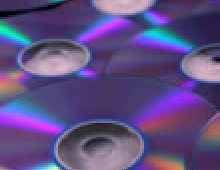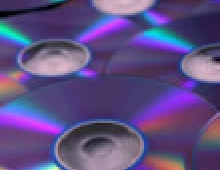
Taiwan develops develop 100GB optical disc
A team of researchers at Taipei's National Taiwan University (NTU) have developed a prototype rewritable optical disc that can store 100GB of information and is compatible with existing CD and DVD technology. The new disc offers far more storage capacity than existing DVD-ROMs, which can store up to 17GB.
The 100GB disc is expected to become commercially available in 2004, when applications such as high-definition TV will create demand for larger storage capacities, said Din Ping Tsai, the professor at NTU who led the research team, in an interview.
The disc, which was developed with the backing of Taiwanese optical disc maker Ritek Corp. and Taiwan's National Science Council (NSC), is able to achieve a higher density of data and greater storage capacity than existing CDs and DVDs through the use of near-field optics, Tsai said.
Unlike other recent advances in optical storage that require the use of blue lasers, the 100GB disc developed by! the NTU team works with the read-write heads found in CD and DVD players that employ red lasers, which have a longer wavelength than blue lasers.
Near-field optics technology increases the disc's storage capacity by allowing a red laser to make recording marks smaller than its diffraction limit, Tsai said. These smaller marks can be spaced more closely together, increasing both storage density and capacity.
To achieve this, two layers have been added to the near-field region of the recording media, Tsai said. The first layer is a transparent layer, called a spacer, that is between 10 nanometers to 20 nanometers thick. The second layer, the active layer, interacts with the laser's focusing spot to create a very small mark size, he said.
Because the interaction between the laser and the recording media takes place in the near-field region, there is no diffraction limit, Tsai said
The only hardware change that is necessary to accommodate! the disc's higher storage capacity is an upgrade to the player's chipset that supports the smaller mark size, Tsai said. The disc can also be used with players that do not have an upgraded chipset but the mark size would not be as small, he said.
Research on the near-field optical disc began in 1998 and has been so far funded to the tune of NT$30 million (US$871,000) by both Ritek and the NSC, he said.
The disc, which was developed with the backing of Taiwanese optical disc maker Ritek Corp. and Taiwan's National Science Council (NSC), is able to achieve a higher density of data and greater storage capacity than existing CDs and DVDs through the use of near-field optics, Tsai said.
Unlike other recent advances in optical storage that require the use of blue lasers, the 100GB disc developed by! the NTU team works with the read-write heads found in CD and DVD players that employ red lasers, which have a longer wavelength than blue lasers.
Near-field optics technology increases the disc's storage capacity by allowing a red laser to make recording marks smaller than its diffraction limit, Tsai said. These smaller marks can be spaced more closely together, increasing both storage density and capacity.
To achieve this, two layers have been added to the near-field region of the recording media, Tsai said. The first layer is a transparent layer, called a spacer, that is between 10 nanometers to 20 nanometers thick. The second layer, the active layer, interacts with the laser's focusing spot to create a very small mark size, he said.
Because the interaction between the laser and the recording media takes place in the near-field region, there is no diffraction limit, Tsai said
The only hardware change that is necessary to accommodate! the disc's higher storage capacity is an upgrade to the player's chipset that supports the smaller mark size, Tsai said. The disc can also be used with players that do not have an upgraded chipset but the mark size would not be as small, he said.
Research on the near-field optical disc began in 1998 and has been so far funded to the tune of NT$30 million (US$871,000) by both Ritek and the NSC, he said.


















